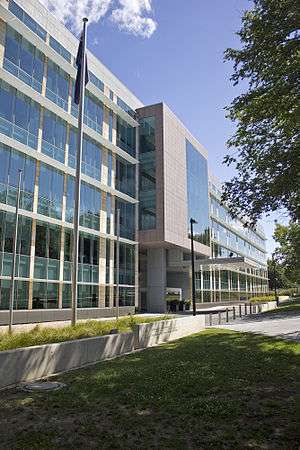Department of the Prime Minister and Cabinet (Australia)
|
| |
 Department of the Prime Minister and Cabinet in Barton, Australian Capital Territory | |
| Agency overview | |
|---|---|
| Formed | 12 March 1971[1] |
| Preceding agency | |
| Jurisdiction | Commonwealth of Australia |
| Employees | 771 (estimate for averaging staffing level for 2013-14)[2] |
| Annual budget | A$140.7 million (2007/08) |
| Ministers responsible |
|
| Agency executive | |
| Child agencies | |
| Website | www.dpmc.gov.au |
The Department of the Prime Minister and Cabinet (PM&C) is an Australian Government department that was established in 1971. The precursor to the Department was known as the Prime Minister's Department and was established in 1911. PM&C's role is to ensure that policy proposals put to the Prime Minister and to Cabinet are developed in a coherent, informed and coordinated fashion, to co-ordinate the implementation of key government programs, to support official visits, ceremonies and state occasions and, to manage the operations of the official residences. The responsibilities of the Department are considerably wider than in most other Westminster systems, although the Department of the Prime Minister and Cabinet in New Zealand has similar responsibilities.
Information about the department's functions and/or government funding allocation could be found in the Administrative Arrangements Orders, the annual Portfolio Budget Statements, in the department's annual reports and on the departmental website.
Structure and staffing
The Department is organised into a Cabinet Division, an Economic Division, an Industry, Infrastructure and Environment Division, an International Division, a National Security Division, a Social Policy Division and a People, Resources and Communications Division and numerous Task Forces to deal with particular problems. The Secretary of the Department, currently Michael Thawley, is the equivalent of the Cabinet Secretary in Britain or the Clerk of the Privy Council in Canada. The acting National Security Adviser is Dr Margot McCarthy.
Staff are employed as Australian Public Service officials under the Public Service Act 1999.[3] In February 2014, The Canberra Times examined pay conditions and staffing records and found that PM&C is one of the public service's best-paid departments and among its least culturally diverse.[4] The following month, then Secretary Ian Watt told his staff that the department was battling to balance its budget and deliver its programs, and that staff would be cut and service delivery reviewed.[5]
Head of Department of the Prime Minister and Cabinet
As mentioned above, the Secretary of the Department of the Prime Minister and Cabinet is the head of the department. It is equivalent to the Prime Minister's office in other countries in the Commonwealth which has Chief of Staff or cabinet secretary. That position is also the head of the Cabinet. The Secretary reports to the Prime Minister, currently the Hon. Malcolm Turnbull MP, and the Cabinet Secretary, currently Senator the Hon. Arthur Sinodinos AO.
Functions
In an Administrative Arrangements Order made on 18 September 2013, the functions of the department were broadly classified into the following matters:[6]
- Advice to the Prime Minister across Government on policy and implementation
- Assistance to the Prime Minister in managing the Cabinet program
- National security policy co-ordination
- Counter terrorism policy co-ordination
- Cyber policy co-ordination
- Intergovernmental relations and communications with State and Territory Governments
- Co-ordination of Government administration
- Australian Government employment workplace relations policy, including equal employment opportunity and administration of the framework for agreement making and remuneration and conditions
- Australian honours and symbols policy
- Government ceremonial and hospitality
- Commonwealth Aboriginal and Torres Strait Islander policy, programs and service delivery
- Promotion of reconciliation
- Native Title
- Community development employment projects
- Reducing the burden of government regulation
- Women’s policies and programs
History
Before 1911, the Prime Minister had no department of his own as such. The Prime Minister was concurrently the Minister for External Affairs, and used the services of the Department of External Affairs.
On 1 July 1911, the Prime Minister's Department was created.[7]
On 11 March 1968, a separate Department of the Cabinet Office was created.[8]
On 12 March 1971, these two departments were merged to create the Department of the Prime Minister and Cabinet.
National Security Adviser of the Department of the Prime Minister and Cabinet
The post of National Security Adviser was formed in December 2008.
| Name | Dates | Notes |
|---|---|---|
| MAJGEN Duncan Lewis, AO, DSC, CSC (Ret'd) | 2008–2011 | Served as the Secretary of the (Australian) Department of Defence |
| Dr Margot McCarthy | 2011 - Incumbent | Acting |
See also
References
- ↑ CA 1401: Department of the Prime Minister and Cabinet, National Archives of Australia, retrieved 27 December 2013
- ↑ Australian Government. "Budget Paper No. 1". 2013-14 Commonwealth Budget. Statement 6: Expenses and Net Capital Investment: Australian Government. Retrieved 24 September 2013.
- ↑ FAQ: The APS, Australian Public Service Commission, archived from the original on 4 November 2013
- ↑ Towell, Noel (15 February 2014). "Glaring pay gap as Aboriginal bureaucrats brought into Prime Minister's department". The Canberra Times. Fairfax Media. Archived from the original on 14 February 2014.
- ↑ Towell, Noel (29 March 2014). "Axe to fall heavily on Prime Minister and Cabinet department". The Canberra Times. Fairfax Media. Archived from the original on 28 March 2014.
- ↑ "Administrative Arrangements Order" (PDF). Department of the Prime Minister and Cabinet. Commonwealth of Australia. 18 September 2013. Archived from the original (PDF) on 14 October 2013. Retrieved 27 October 2013.
- ↑ CA 12: Prime Minister's Department, National Archives of Australia, retrieved 27 December 2013
- ↑ CA 1285: Department of the Cabinet Office, National Archives of Australia, retrieved 27 December 2013

